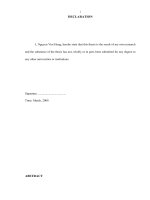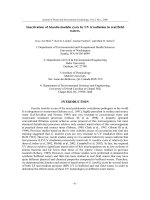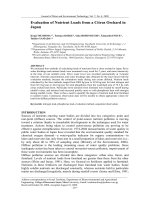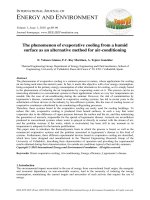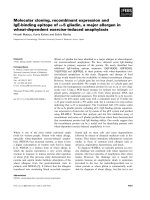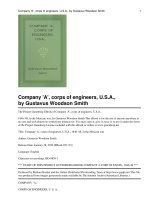Numerical modeling of tidal modulated dispersion of brine discharges from a desalination plant in singapore coastal waters
Bạn đang xem bản rút gọn của tài liệu. Xem và tải ngay bản đầy đủ của tài liệu tại đây (1.81 MB, 129 trang )
NUMERICAL MODELING OF TIDAL-MODULATED DISPERSION
OF BRINE DISCHARGES FROM A DESALINATION PLANT IN
SINGAPORE COASTAL WATERS
SINAPAH SWAMI DIDIER
NATIONAL UNIVERSITY OF SINGAPORE
2003
NUMERICAL MODELING OF TIDAL-MODULATED DISPERSION
OF BRINE DISCHARGES FROM A DESALINATION PLANT IN
SINGAPORE COASTAL WATERS
SINAPAH SWAMI DIDIER
(B. Sc. Eng, Ecole Nationale des Ponts et Chaussées, France)
A THESIS SUBMITTED
FOR THE DEGREE OF MASTER OF ENGINEERING
DEPARTMENT OF CIVIL ENGINEERING
NATIONAL UNIVERSITY OF SINGAPORE
2003
1
ACKNOWLEDGMENT
This Research would not have been possible without help and support from many people
and organizations. I wish particularly to express my greatest gratitude to the following:
-
My supervisor, Dr Lin Pengzhi, for his invaluable advice and support throughout the
whole research
-
Post-Doctoral Dr Wu Yonsheng for his guidance and his expertise in numerical
modelling
-
Staffs of National University of Singapore and Ecole Nationale des Ponts et
Chaussées for making this agreement between France and Singapore possible.
-
Finally, my family, who has supported me during this whole period away from
home, and my friends, both in France and in Singapore, for their patience,
encouragement, understanding and continuous support throughout my research.
2
TABLE OF CONTENTS
ACKNOWLEDGMENT ....................................................................................................2
TABLE OF CONTENTS ...................................................................................................3
SUMMARY .........................................................................................................................8
NOMENCLATURE..........................................................................................................10
LIST OF FIGURES ..........................................................................................................14
LIST OF TABLES ............................................................................................................17
CHAPTER 1
– INTRODUCTION..............................................................................18
1.1
GLOBAL CONCERN AND PROBLEMATIC ................................................................18
1.2
SINGAPORE CONTEXT ...........................................................................................19
1.3
EFFLUENT DISCHARGE AT SEA OUTFALL .............................................................20
1.4
AIM OF STUDY......................................................................................................21
1.5
THESIS ORGANIZATION ........................................................................................22
CHAPTER 2
– LITERATURE REVIEW .................................................................23
2.1
INTRODUCTION ....................................................................................................23
2.2
THREE-DIMENSIONAL HYDRODYNAMIC MODELS..................................................24
2.2.1
Theory-Hydrodynamic equations................................................................24
2.2.1.1
Basic approximations..............................................................................25
2.2.1.2
General basic equations ..........................................................................26
3
2.2.2
2.2.2.1
z-coordinate models ................................................................................28
2.2.2.2
ρ-coordinate models................................................................................28
2.2.2.3
σ-coordinate models................................................................................29
2.2.3
Horizontal coordinate and discretisation ...................................................31
2.2.3.1
Horizontal coordinate..............................................................................31
2.2.3.2
Horizontal discretisation .........................................................................32
2.2.4
Boundaries conditions ................................................................................33
2.2.4.1
Open boundary conditions ......................................................................33
2.2.4.2
Coastal boundaries conditions ................................................................34
2.2.5
2.3
Vertical discretisation.................................................................................28
Turbulence ..................................................................................................34
THREE-DIMENSIONAL WATER QUALITY MODELS ..................................................36
2.3.1
Classifications of water quality model........................................................36
2.3.2
Conceptual approach of coastal water quality applications ......................40
2.3.3
Three-dimensional water quality model in tropical coastal waters ...........42
2.3.4
Plumes dispersion and brine discharge modelling.....................................43
2.4
2.3.4.1
Typical behavior of sea outfall discharge ...............................................43
2.3.4.2
Review of studies....................................................................................45
SUMMARY OF RESEARCH GAPS ADDRESSED BY THE STUDY ..................................46
CHAPTER 3
- THREE-DIMENSIONAL HYDRODYNAMIC MODEL ..............47
3.1
OUTLINE ..............................................................................................................47
3.2
GOVERNING EQUATIONS ......................................................................................47
3.2.1
Turbulent flow: Reynolds Averaged Navier Stokes Equations ...................47
4
3.2.2
Eddy viscosity concept ................................................................................49
3.2.3
Turbulence schemes ....................................................................................50
3.2.3.1
Parameterization of vertical processes: k − ε model .............................51
3.2.3.2
Parameterization of horizontal diffusion ................................................52
3.2.4
Governing equations summary ...................................................................52
3.3
BOUNDARIES CONDITIONS ...................................................................................54
3.4
NUMERICAL MODEL .............................................................................................55
3.4.1
Introduction.................................................................................................55
3.4.2
Model grid and spatial discretisation .........................................................55
3.4.3
Time discretisation......................................................................................58
3.4.4
User-defined resolution ..............................................................................59
3.4.5
Solution Procedure .....................................................................................60
CHAPTER 4
- VALIDATION OF LARGE-SCALE MODEL................................61
4.1
OUTLINE ..............................................................................................................61
4.2
MODEL SET-UP ....................................................................................................61
4.2.1
Study Area...................................................................................................61
4.2.1.1
Geographic and bathymetric conditions .................................................61
4.2.1.2
Tidal conditions ......................................................................................62
4.2.1.3
Climatologic conditions ..........................................................................63
4.2.2
Numerical computation...............................................................................63
4.2.2.1
Computational domain............................................................................63
4.2.2.2
Boundary conditions ...............................................................................64
4.2.2.3
Model input parameters ..........................................................................65
5
4.2.3
4.3
Validation procedure ..................................................................................66
RESULTS AND DISCUSSION...................................................................................68
4.3.1
Results .........................................................................................................68
4.3.2
Discussion ...................................................................................................68
CHAPTER 5
5.1
– LOCAL MODEL ...............................................................................77
PRESENTATION OF THE CASE STUDY.....................................................................77
5.1.1
Introduction.................................................................................................77
5.1.2
Objective of the study..................................................................................78
5.1.3
Condition of discharge................................................................................78
5.2
5.1.3.1
Geographical situation of desalination plant and discharges..................78
5.1.3.2
Bathymetry of the discharge area ...........................................................80
5.1.3.3
Hydrodynamic conditions.......................................................................80
5.1.3.4
Characteristics of brine discharge...........................................................81
5.1.3.5
Outfall design..........................................................................................81
MODEL SETUP......................................................................................................82
5.2.1
Computational domain................................................................................82
5.2.2
Coherens-based Local Model .....................................................................82
5.2.3
Bathymetry recovery ...................................................................................82
5.2.4
Near field approximations ..........................................................................85
5.2.5
Boundary, meteorological and wave conditions.........................................86
5.2.6
Model input parameters..............................................................................87
5.3
RESULTS AND DISCUSSION...................................................................................89
5.3.1
Monitoring and Analysis Plan ....................................................................89
6
5.3.2
Hydrodynamic stage for the discharge .......................................................91
5.3.3
Dispersion at the vicinity of the discharge and time variations .................92
5.3.4
Horizontal distribution................................................................................92
5.3.5
Environmental aspects ................................................................................94
5.3.6
Effect of assumptions ..................................................................................95
CHAPTER 6
CONCLUSION ...................................................................................106
6.1
SUMMARY OF RESEARCH CONTRIBUTIONS .........................................................106
6.2
LIMITATIONS AND FUTURE RESEARCH................................................................107
REFERENCES: ..............................................................................................................108
APPENDIX A ..................................................................................................................121
A.
MATHEMATICAL REPRESENTATION: GENERAL FORM OF A SCALAR ADVECTION-
DIFFUSION EQUATION .....................................................................................................122
APPENDIX B ..................................................................................................................124
B.
TIDAL PREDICTION MODEL: HARMONIC METHOD AND HYDRODYNAMIC
CONSIDERATIONS ...........................................................................................................125
B.1
Traditional full harmonic methods ...............................................................125
B.2
Limitations: hydrodynamic considerations...................................................127
B.3
Tidal Constituents Table: Example...............................................................128
7
SUMMARY
Simulations of coastal processes in Singapore’s waters have been carried out, in the past,
using two-dimensional or multi level models. A better understanding of these processes,
which is essential for a sustainable economic development in the coastal area, requires
more accurate analysis and modeling tools such as full three-dimensional models. The
purpose of this study was to develop a full three-dimensional model for Singapore’s
coastal waters, based of the latest developments of the art, and to apply it to simulation of
tidal motions and salinity distribution for two different length-scales.
First, a full three-dimensional large-scale model, covering Singapore and its surrounding,
have been developed to simulate tides and tidal currents. The model is derived from
COHERENS, a recently coupled hydrodynamic-ecological model for regional and shelf
seas originally developed for the North Sea. The governing equations are solved using a
conservative finite difference analysis, an Arakawa “C” grid system and a σ-coordinate
system in the vertical direction. A mode-splitting technique coupled with a predictorcorrector algorithm is applied to save of computational time. The equations are discretised
in explicit, semi-implicit and implicit schemes. As far as parameterization of vertical
processes is concerned, a k − ε model is selected. A recent form of stability function
derived in Luyten et al. (1996) insures the stability of the scheme.
The numerical model is validated against a range of observed parameters such as tidal
elevations and applied for the simulation of tides and tidal currents. As a result, the
8
accuracy of the model is proven and the numerical stability that had limited the
implementation of full 3D model is achieved.
Another full three-dimensional model, also derived from COHERENS, covering a local
domain in the southwest coast of Singapore is developed. The model was developed for
purpose of numerical modeling of tidally modulated dispersion of brine waste discharges
from a coastal desalination plant, and was inspired by the Desalination Plant Programme
of Singapore’s authorities. Due to the lack of data, a bathymetry recovery of the domain is
performed using interpolation techniques. Since the study focuses on the mixing processes
in the far field, a near field mixing approximation is achieved. The simulation is carried
out for sea and weather conditions favorable for this type of study (critical conditions):
absence of wind and no wave-current interaction. The open boundaries conditions are
generated, implementing harmonic constituents method.
Eventually, the horizontal and vertical distribution profiles of the brine in dilution are
simulated. As expected, the dispersion of the brine mass is governed by the joint effects of
negative buoyancy and hydrodynamics the tidal currents. The dilution rate is very high
and the salinity level drops rapidly as one moves away from the source. Indeed, at distance
from the discharge, along the coast in particular, the salinity does not exceed 1 PSU above
the ambient seawater salinity. As a result, this numerical model demonstrates the
applicability of full three-dimensional model for this type of study, as well as the
feasibility of this desalination plant for Singapore, from an environmental point of view
and as the first approximation.
9
NOMENCLATURE
ρa
air density
τ b2
bottom shear lateral component
τ b1
bottom shear longitudinal component
cµ
constant: 0.09
σk
constant: 1.0
σε
constant: 1.22
CD
drag coefficient
x1
equivalent to x in Cartesian system
x2
equivalent to y in Cartesian system
x3
equivalent to z in Cartesian system
Φ′
fluctuating component for any variable Φ
Ax
horizontal turbulent viscosity/diffusivity coefficient
Ay
horizontal turbulent viscosity/diffusivity coefficient
ρ0
reference density
S0
reference salinity
T0
reference temperature
βS
salinity expansion coefficients
cp
specific heat of the seawater at constant pressure
10
τ s2
surface stress lateral component
τ s1
surface stress longitudinal component
Φ ( xi , t )
variable, function of space coordinate and time coordinate
Az
vertical turbulent viscosity/diffusivity coefficient
τ ij
viscous stress tensor
V10
wind vector at a reference height of 10m, lateral component
U10
wind vector at a reference height of 10m, longitudinal component
βT
thermal expansion coefficients
(λ,Φ,z)
spherical coordinates: λ, Φ represent respectively the latitude and the
longitude k − ε name of turbulence scheme
1D
one-dimensional
2D
two-dimensional
3D
three-dimensional
g
acceleration of gravity
BOD biological oxygen demand
Ci
checkpoint for output
c1
constant: 1.44
c2
constant: 1.92
ε
dissipation rate of kinetic energy
DO
dissolved oxygen
H
depth of the water column
h
water depth of still water
11
λ
heat conduction coefficient
υH
horizontal eddy coefficient
K1
tidal harmonic constituent
k
kinetic energy
φ
latitude
M1
tidal harmonic constituent
Φ
mean value for any variable Φ
υ
molecular viscosity coefficient
O1
tidal harmonic constituent
Oi
checkpoint for output
p
pressure
P
production of turbulent energy by the mean velocity gradients
Ω
rotation frequency of the earth
S2
tidal harmonic constituent
S
salinity of the fluid
I
solar irradiance
T
temperature of the fluid
f
the Coriolis frequency
U
node reference in x direction
un+1
adjusted current in x direction
up
predicted current in x direction
V
node reference in y direction
u
velocity component in x direction
12
v
velocity component in y direction
w
velocity component in z direction
υT
vertical eddy coefficient
Vi
checkpoint for output
vn+1
adjusted current in y direction
ρ
volumic mass of the fluid or water density
vp
predicted current in y direction
W
node reference in z direction
ζ
water elevation
x
longitudinal coordinate in Cartesian system
y
lateral coordinate in Cartesian system
z
vertical coordinate in Cartesian system
η
sea surface elevation
σ
transformed vertical coordinate
13
LIST OF FIGURES
Figure 2.1 - Three main types of vertical coordinate representation in ocean modelling. .30
Figure 2.2 – Conceptual model...........................................................................................40
Figure 2.3 – Typical behavior of wastewater discharged from ocean outfall.....................44
Figure 2.4 – Typical structure of plume from wastewater discharged from ocean outfall 44
Figure 3.1 – Location of state variables..............................................................................57
Figure 4.1 – Map of the region and location of study area .................................................70
Figure 4.2 – Location of study area ....................................................................................70
Figure 4.3 - Bathymetry of study area ................................................................................71
Figure 4.4 – Computational domain and stations H1, H2, H3............................................71
Figure 4.5 - East Boundary Condition – Tidal elevation measured data ...........................72
Figure 4.6 - West Boundary Condition – Tidal elevation measured data...........................72
Figure 4.7 – South-East Boundary Condition – Tidal elevation measured data.................73
Figure 4.8 – South-East Boundary Condition – Tidal elevation measured data.................73
Figure 4.9 – Measured and computed tidal elevation at station H1....................................74
Figure 4.10 – Measured and computed tidal elevation at station H2..................................74
Figure 4.11 – Measured and computed tidal elevation at station H2..................................75
Figure 4.12 – Circulation patterns for depth-averaged velocities under flood condition
during spring tide ........................................................................................................75
Figure 4.13 - Circulation patterns for depth-averaged velocities under ebb condition
during spring tide ........................................................................................................76
14
Figure 5.1 – Location of study area and outfall on Large Scale map .................................79
Figure 5.2 – Location of study area and outfall on Singapore map....................................79
Figure 5.3 – Location of desalination plant and main outfall .............................................80
Figure 5.4 – Recovered bathymetry for Local Model – 2D................................................84
Figure 5.5 – Recovered bathymetry for Local Model – 3D................................................84
Figure 5.6 Locations of checkpoints for hydrodynamic analysis and brine dispersion
analysis........................................................................................................................96
Figure 5.7 – Computed tidal elevation at location V1 (left) and V2 (right) .......................97
Figure 5.8 - Computed tidal elevation at location V3.........................................................97
Figure 5.9 - Circulation patterns for depth-averaged velocities – ebb condition................98
Figure 5.10 - Circulation patterns for depth-averaged velocities – flood condition...........98
Figure 5.11 – Salinity level at sea bottom right next to the discharge, northward (left) and
southward (right).........................................................................................................99
Figure 5.12 - Salinity level 100m away from discharge northward (left) and southward
(right) ..........................................................................................................................99
Figure 5.13 - Representation of the vertical profile of salinity level at the vicinity of the
discharge ...................................................................................................................100
Figure 5.14 –Time variations of salinity level at sea bottom, in coastal area: C1 (left) and
C2 (right)...................................................................................................................101
Figure 5.15 - Time variations of salinity level at sea bottom, in open sea area: O1 (left)
and O2 (right)............................................................................................................101
Figure 5.16 - Time variations of salinity level at sea bottom, in open sea area: O3 (left)
and O6 (right)............................................................................................................102
15
Figure 5.17 - Time variations of salinity level at sea bottom, in open sea area: O4 (left)
and O5 (right)............................................................................................................102
Figure 5.18 - Time variations of salinity level at sea bottom, in open sea area: O7 (left)
and O8 (right)............................................................................................................103
Figure 5.19 – Horizontal distribution of salinity level at sea bottom. (psu) .....................103
Figure 5.20 - Horizontal distribution of salinity level at intermediate level.....................104
Figure 5.21 - Horizontal distribution of salinity level at sea surface................................105
16
LIST OF TABLES
Table 2.1- Criteria for classification of water quality model..............................................38
Table 2.2 - Examples of water quality models for management analysis ..........................39
Table 2.3-– Description of selected models........................................................................39
Table 4.1- Model setup parameters for time, space and reference values ..........................65
Table 4.2 – Model setup parameters for advection diffusion, turbulence and boundaries
conditions....................................................................................................................66
Table 5.1 - Model setup parameters for time, space and reference values .........................87
Table 5.2 – Model setup parameters for advection diffusion, turbulence and boundaries
conditions....................................................................................................................88
17
Chapter 1 – Introduction
1.1 Global concern and problematic
The coastal region comprises of only a narrow stretch of land and sea extending a few tens
of kilometers on either side of the shoreline. According to the Office of Naval Research
International Field Office (ONRIFO) in its Ocean Science and Engineering Newsletter
(Ali, B.H., 2000), the coastal area that occupies less than 10% of the surface and 1% of its
volume accounts for nearly a quarter of oceanic biological production. It is also said that,
60% of the human population and two-thirds of the mega-cities are located in the coastal
zone. Hence, the coastal zone represents the primary economic and social zone for human
activities. Concomitantly, an international concern about the undoubted and substantial
deterioration of the environmental quality of the coastal zone due to manmade and natural
events is growing. Countless examples of alarming pollution events exist in all coastal
regions in the world. It is gradually becoming understood that the design of remedial
actions must rest on a clearer understanding of the physical, geomorphological and
biological processes in the coastal zone. As a matter of fact, a sustainable, demographic
and economic development of the coastal regions of the world makes necessary an
interdisciplinary effort (UNESCO, CSI, 1999). The research in fields such as
hydrodynamic and biology in combination with computer models provide helpful tools to
study the behavior of coastal waters and ecosystems. These so-called numerical ocean
models represent essential means to increase our ability to understand and monitor coastal
marine systems, and to a limited extent, even predict their future state.
18
1.2 Singapore context
Due to its geographic and economic context, coastal issues particularly concern Singapore,
a 690-km2 island, off the southern tip of the Malay Peninsula. The coastal waters of
Singapore comprise of the Johor Strait in the north and the Singapore Strait that stretches
from the Malacca Straits to the northwest, to the Java Sea to the south and the South China
Sea to the east. In past four decades, Singapore coast has experienced rapid and huge
transformations such as land reclamation and portal infrastructure construction. The
continuous economic development of the island has led and is leading to an inevitable and
increasing degradation of the coastal strips.
In the past, studies to understand the coastal processes in Singapore such as erosion, tides
and tidal currents, and the phytoplankton dynamics have been carried out.
Tham (1953) was one the first scientists who conducted extensive investigations on the
hydrodynamics and the marine ecosystem of Singapore waters. Later, some water quality
studies targeting temperature, salinity, dissolved oxygen, nutrients concentration and
planktological characteristics were published in such as Gin (2000). The physical
characteristics of Singapore’s coastal waters have been also studied in the past. In 1979, a
tides and tidal currents studies in the Straits of Malacca and Singapore were jointly carried
out by Indonesian, Malaysian, Singaporean and Japanese teams. Several numerical
hydrodynamic models also have been developed (Koh et al, 1997; Cheong et al., 1992;
Shankar et al., 1997; Zhang 2000). Although the complexity of the processes requires the
use of full three-dimensional numerical, so far, few have been applied to Singapore’s
coastal waters. The main reason was numerical limitations (Zhang, 1999). By employing
19
the latest developments of full three-dimensional models one can expect to overcome
these numerical limitations; and therefore, end up with a more accurate and efficient tool
to study coastal processes in Singapore’s coastal waters.
1.3 Effluent Discharge at Sea Outfall
Uncontrolled effluent discharge and unwell-designed sea outfalls can be the cause of
considerable adverse effects on human communities as well as all forms of life in the
marine system. The main objective of sea outfall is to discharge the effluent by
minimizing detrimental effects on the receiving water. Basically, the discharge should
occur at an adequate distance from the shore and should also take into account the local
hydrodynamic effects that assist the dispersal of the effluent. Thus, in order to correctly
conceive an outfall, hydrodynamic and dispersal studies should be carried out to predict
the environmental impact of the discharge. The three-dimensional model can represent a
good quality and cost-effective tool to assist the design of the sea outfall (Quetin et al.,
1986)
20
1.4 Aim of study
This study aims to reach the following objectives:
1. Develop a full hydrodynamic three-dimensional Large-Scale Model for
Singapore’s coastal waters, based on COHERENS (Luyten et al.,
1999), a coupled hydrodynamical-ecological model for regional and
shelf seas.
2. Validate the numerical Large Scale Model and simulate tides and tidal
motions in Singapore’s waters.
3. Develop a three-dimensional plume dispersion model for a local
domain on the west coast of Singapore (Local Model).
4. Apply the Local Model on the numerical modeling of tidally modulated
dispersion of brine waste discharges from a coastal desalination plant.
5. Estimate under the most critical pollution conditions, the environmental
impact of such a discharge.
In order to achieve this study, a numerical model, called COHERENS, has been modified,
validated against a wide range of observed physical parameters such as tidal elevations,
temperature, and salinity. The Large Scale Model is used to simulate tides and tidal
currents in Singapore’s coastal waters.
Besides the development and the validation of this model, the second objective of a largescale study consists of properly apprehending tidal phenomena those of which are large in
length scale.
21
Similar to the Large Scale Model, the Local Model has been developed by modifying
COHERENS. The Local Model covers a domain beyond the area affected by the
discharge. The Local Model is lastly applied for the simulation of brine dispersion.
Because COHERENS (Luyten et al., 1999) is one of the most recent full threedimensional multi-purpose models (Moll, 2003), the application that has been developed
for this study is expected to simulate processes efficiently and to provide accurate results
for Singapore’s waters behavior.
1.5 Thesis Organization
Chapter 1 described the problems of coastal processes when applying numerical
modelling, such as, in effluent discharge, reviewed the studies carried out in Singapore’s
coastal waters and defined the objectives of this study; Chapter 2 reviews the recent
development in ocean and coastal modelling, and in plume dispersion modelling. Chapter
3 introduces the basic hydrodynamic equations, and the features of the numerical model.
The validation of the three-dimensional hydrodynamic model is presented in Chapter 4.
Chapter 5 deals with the presentation and the results of the tidally modulated brine
dispersion numerical model.
22
Chapter 2 – Literature review
2.1 Introduction
In the past decades, coastal areas have been suffering from major environmental
degradations due to human economic activities. In order to design remedial actions, the
need for a better understanding of the hydrodynamic, bio-chemical processes has
catalyzed the development of more efficient accurate, and reliable tools of analysis and
modelling. For the assessment of coastal processes many numerical models are already in
place. They are divided into three classes: the one-dimensional models, the twodimensional models and the three-dimensional models. The one-dimensional models only
suitable for unidirectional flow, river flow for example, cannot be applied in coastal
waters simulation. Most models are two-dimensional (Tappin et al., 1997; Prandle et al,
1993, HydroQual®, Neuse Estuary Eutrophication Model®...etc). These models, also
called “depth- averaged models”, assume hydrostatic pressure distribution and weak
variation in vertical space like vertically well-mixed estuary (Cox, 2003). However, to
simulate a phenomenon such as pollutant transport around the discharge point or complex
physical, bio-chemical processes, the use of three-dimensional models are necessary. This
chapter reviews the developments of numerical three-dimensional hydrodynamic models,
water quality models, as well as the modelling of plume dispersion.
23
2.2 Three-dimensional hydrodynamic models
The many improvements in the development of three-dimensional numerical models for
fields such as hydrodynamics and oceanography have helped us to accurately simulate,
understand and predict natural phenomena such as tidal motion, storm surge, etc.
Nevertheless, many phenomena can still be numerically reproduced in a very simple way.
In the following part, we briefly review the range of numerical methods (and associate
models) available nowadays to represent and parameterize some key phenomena in ocean
modeling, especially in coastal modeling (Griffies, 2000).
2.2.1 Theory-Hydrodynamic equations
The movement of ocean currents as well as many other fluid flow phenomena such as air
in the atmosphere is governed by the Navier-Stokes Equations and the Continuity
Equation and the Energy Equation (these fundamental equations are presented further on).
The equations are the result of the fundamental principles of mass, momentum and energy
balances into an infinitesimal control volume. In the most general case, the variables to be
solved are the velocity components u , v, w , the pressure p , the volumic mass of the fluid
ρ , the temperature of the fluid T and the salinity of the fluid S . These variables are all
functions of space coordinate and time coordinate: Φ ( xi , t ) .
24
